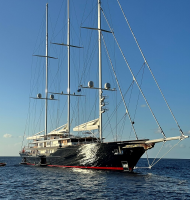The global economy has experienced several major shocks in recent years. A period of normalisation has now begun. Once the dust settles, we’ll see if there are any differences from the pre-pandemic world. To discover these, we must seek out striking and deviating patterns.
When the international freight traffic was disrupted during the pandemic, economists began paying closer attention to overseas container transport. Over the last two years, a development has emerged that you could rightly call worrying for Europe.
Two German research institutions, RWI and ISL, gather monthly figures on container handling in 92 ports worldwide. The chart below shows the series for the ‘world’ as a whole and for Northwest Europe (Hamburg, Bremen/Bremerhaven, Rotterdam, Antwerp, Zeebrugge, and Le Havre).
Container handling

The worrying part is evident. Container handling in Northwest Europe followed the pattern elsewhere until 2021. But from mid-2021, the picture changed. We saw a significant drop, unlike the rest of the world.
What caused this divergence? What happened here that didn’t occur elsewhere? This is where speculation begins, so we must be careful not to draw overly firm conclusions. But if various puzzle pieces fit together, a realistic picture of what’s happening may emerge.
A notable difference between Europe and the rest of the world in 2021 was the development of the gas price. From the beginning of the year to Christmas, it increased ninefold in Europe. In the US, gas prices also rose, but much less. The developments and the differences were even more dramatic in 2022, particularly due to the war. The European gas price exploded and peaked at the end of August. Fortunately, it has significantly dropped since then, but it is still almost double the pre-pandemic level and three times higher than the American price. Also, the US is more than self-sufficient in gas, while Europe is a large importer, which makes supply less secure.
Natural gas prices

No wonder that energy-intensive sectors in Europe are struggling under these conditions. The rise in energy prices has led to a substantial production decline in these sectors. For instance, in May, production in the chemical sector in our country was more than 18% lower than a year earlier, and in the rubber and plastics sector nearly 11% lower. The decline in European gas prices since last August has not yet led to a significant recovery in production. Therefore, it is reasonable to ask whether part of the activity in these sectors is permanently lost. Elsewhere, energy prices are structurally lower, supply is more secure, and energy policy is perhaps clearer or at least friendlier to these sectors. So, production might have been relocated.
This is really serious
How bad would a loss of activity in energy-intensive sectors be? The German statistical office provides interesting insights about the situation in our neighbouring country. The energy-intensive industry is under pressure there too, accounting for around 2.5% of all employment. The labour productivity of these sectors is much higher than the average for the industry as a whole. And that is again much higher than the average labour productivity in the economy as a whole. Thus, these sectors contribute significantly above average to the added value and hence to prosperity. And that’s not just for the people working in these sectors, but for society as a whole. Losing a significant part of that activity permanently would be painful. The relative impoverishment that could result might already be reflected in the container handling in our ports.
The public debate in Europe does not focus on the developments described here. It would be beneficial if we paid more attention to preserving our prosperity. Of course, in addition to all the other important matters.
Han de Jong is the former Chief Economist of ABN Amro. He writes weekly for Investment Officer about economics and markets. You can read more about his views on Crystal Clear Economics. This article was originally published in Dutch on InvestmentOfficer.nl.












